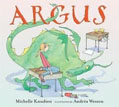 
|
Mrs. Henshaw has given all her students an egg to hatch. Sally’s egg is neither white nor small like the other eggs, and it doesn’t have a chick inside. When Sally’s polka-dotted egg hatches, the students say, “Ewww!”
Sally notices that her hatchling is different from the other hatched chicks, but when she tries to talk to her teacher about the problem she is told, “Don’t be difficult.”
A baby dragon being raised as a chick will cause problems, though - havoc in the classroom when he chases after his food, and huge holes in the schoolyard when he practices his pecking. With this story, children will come to anticipate the repetitive phrase “Don’t be difficult” and chuckle at the absurdity of mistaking a dragon for a chick.
The illustrations, which are rendered in watercolor and ink, show an organized classroom dedicated to learning about science. Fish and insect decorations hang from the ceiling and seedlings sit on a desk. There is a moment in the story when the baby dragon (named Argus) disappears, but the story does end with a happy reunion.
Sally brings Argus back to school and completes her pie chart entitled “My Chick.” Although it looks similar to the others in terms of eating and sleeping patterns, Sally’s chart is the only one with a section dedicated to the love she feels for her ‘chick’ – and it earns her a gold star.
Michelle Knudsen is the author of the picture book Library Lion. She lives in New York. Andréa Wesson’s illustrations can be seen in the Evangeline Mudd novels by David Elliott. She lives in Maryland.
Andrea Wesson has written and illustrated many books for children, including Giant Meatball and Can You Dig It?. He lives in Brooklyn.
|







|